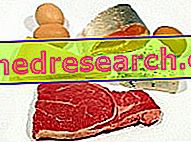What are the most protein-rich foods?
Proteins are the building blocks of living organisms. This peculiar function, called plastic, is not the only one. Proteins are in fact also responsible for the synthesis of hormones, enzymes and tissues (especially the muscular one).

From the chemical point of view, proteins are macromolecules consisting of 22 fundamental units called AMINO ACIDS, which, like many rings, join together to form a long chain.
Eight of these amino acids are essential because the body cannot synthesize them at sufficient speed to meet the metabolic demands. These amino acids (leucine, isoleucine, lysine, methionine, valine, threonine, phenylalanine, tryptophan) must therefore be introduced with food, in order to avoid specific nutritional deficiencies. In the first two years of life two other amino acids become essential, called arginine and histidine respectively
Not all proteins are the same
In foods of animal origin you can find "high biological value" proteins: it simply means that these foods contain all the "essential" amino acids in the right proportions and quantities.
The proteins present in plant foods instead have a worse amino acid profile, as they lack one or more "essential" amino acids. This deficit can however be easily filled, by combining vegetable foods of different origins (such as the classic pasta and beans). See: vegetable proteins.
QUALITY OF PROTEINS
To evaluate the quality of proteins present in foods, three parameters are used:
CUD (digestive utilization coefficient): is given by the ratio between absorbed nitrogen and ingested nitrogen (Na / Ni): the CUD is high for proteins of animal origin, less for proteins of vegetable origin;
PER (protein efficiency ratio): based on the study of the growth curves of batches of animals fed with proteins: it indicates the gain in body weight for every gram of ingested protein;
NPU (net protein utilization = net protein utilization): expresses the digestibility and the biological value of the protein.
How many proteins?
The recommended dietary protein intake is inversely proportional to age:
2 g / kg / day in the newborn
1.5 g / kg / day at 5 years
1-1.2 g / kg / day in adolescence and adulthood
These proteins should derive 2/3 from foods of animal origin and 1/3 from foods of plant origin.
EXCESS OF PROTEIN: correlates to overweight and increased renal and hepatic effort. An excess of animal protein associated with high amounts of saturated fat (beef, pork or other lipid-rich red meat) is one of the risk factors for colon cancer and numerous other diseases. See: Diet and cancer
Protein-rich foods
| Foods with higher protein content | |
| FOOD | g protein / 100 g |
| SOY SOYBEAN | 36.9 |
| GRAIN | 33.9 |
| BRESAOLA | 32 |
| PINE NUTS | 31.9 |
| ROASTED PEANUTS | 29 |
| RAW HAM | 28 |
| SALAMI | 27 |
| ... | |
| DRIED BEANS | 23.6 |
| CHICKEN BREAST | 23.3 |
| FRESH TUNA | 21.5 |
| ADULT BABY THREAD | 20.5 |
| COD OR NOSE | 17.0 |
| Food | Biological value |
| EGGS | 100 |
| MILK | 91 |
| BEEF | 80 |
| FISH | 78 |
| SOYA PROTEIN | 74 |
| RICE | 59 |
| WHEAT | 54 |
| PEANUTS | 43 |
| DRIED BEANS | 34 |
| POTATO | 34 |
NB cooking food greatly reduces the biological value of proteins
| supplements | Biological value |
| MILK SERUM PROTEINS | > 100 |
| EGG PROTEIN | 100 |
| MILK'S PROTEINS | > 90 |
| PROTEIN OF CASEIN | <80 |
| SOYA PROTEIN | <75 |
| WHEAT PROTEIN | <55 |
What are the foods richest in a specific amino acid?
Below is the amino acid profile of the most common foods. Clicking on this icon will open a dedicated page, which will allow you to discover, for example, that toasted peanuts are the richest food of the amino acid arginine.




